Chapter 1 Linear Equations
1.4 Slope of a Line
Learning Objectives
By the end of this section, you will be able to:
- Find the slope of a line
- Graph a line given a point and the slope
- Graph a line using its slope and intercept
- Choose the most convenient method to graph a line
- Graph and interpret applications of slope–intercept
- Use slopes to identify parallel and perpendicular lines
Find the Slope of a Line
When you graph linear equations, you may notice that some lines tilt up as they go from left to right and some lines tilt down. Some lines are very steep and some lines are flatter.
In mathematics, the measure of the steepness of a line is called the slope of the line.
The concept of slope has many applications in the real world. In construction, the pitch of a roof, the slant of plumbing pipes, and the steepness of the stairs are all applications of slope. As you ski or jog down a hill, you are experiencing slope.
We can assign a numerical value to the slope of a line by finding the ratio of the rise to the run. The rise measures the vertical change, while the run measures the horizontal change as you move along the line from one point to another. This is shown in the illustration below. Slope is a rate of change.
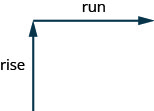
Slope of a Line
The slope of a line is [latex]m=\frac{rise}{run}[/latex].
The rise measures the vertical change, and the run measures the horizontal change.
To find the slope of a line, we locate two points on the line whose coordinates are integers. Then we sketch a right triangle where the two points are vertices and one side is horizontal and one side is vertical.
To find the slope of the line, we measure the distance along the vertical and horizontal sides of the triangle. The vertical distance is called the rise, and the horizontal distance is called the run.
Find the slope of a line from its graph using
[latex]m=\frac{rise}{run}[/latex].
- Locate two points on the line whose coordinates are integers.
- Starting with one point, sketch a right triangle, going from the first point to the second point.
- Count the rise and the run on the legs of the triangle.
- Take the ratio of rise to run to find the slope: [latex]m=\frac{rise}{run}[/latex].
Example 1
Find the slope of the line shown.

| Locate two points on the graph whose
coordinates are integers. |
[latex](0,5)[/latex] and [latex](3,3)[/latex] |
| Starting at [latex](0,5)[/latex], sketch a right triangle to
[latex](3,3)[/latex] as shown in this graph. |
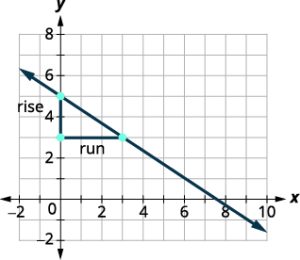 |
| Count the rise—since it goes down, it is negative. | The rise is [latex]-2[/latex] |
| Count the run. | The run is [latex]3[/latex]. |
| Use the slope formula. | [latex]m=\frac{rise}{run}[/latex] |
| Substitute the values of the rise and run. | [latex]m=\frac{-2}{3}[/latex] |
| Simplify. | [latex]m=\frac{-2}{3}[/latex] |
| The slope of the line is [latex]\frac{-2}{3}[/latex]. | |
| So y decreases by 2 units as x increases by 3 units. |
Exercise 1
How do we find the slope of horizontal and vertical lines? To find the slope of the horizontal line [latex]y=4[/latex], we could graph the line, find two points on it, and count the rise and the run. Let’s see what happens when we do this, as shown in the graph below.
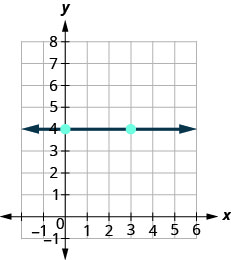
| What is the rise? | The rise is 0. |
| What is the run? | The run is 3. |
| What is the slope? | [latex]\begin{array}{lrcl} & m & = & \frac{rise}{run}\\ & m & = & \frac{0}{3}\\ & m & = & 0\\ \end{array}[/latex] |
| The slope of the horizontal line [latex]y=4[/latex] is 0. |
Let’s also consider a vertical line, the line [latex]x=3[/latex], as shown in the graph.
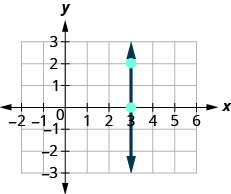
| What is the rise? | The rise is 2. |
| What is the run? | The run is 0. |
| What is the slope? | [latex]\begin{array}{lrcl} & m & = & \frac{rise}{run}\\ & m & = & \frac{2}{0}\\ \end{array}[/latex] |
| The slope is undefined since division by zero is undefined. So we say that the slope of the vertical line [latex]x=3[/latex] is undefined. | |
All horizontal lines have slope 0. When the y-coordinates are the same, the rise is 0.
The slope of any vertical line is undefined. When the x-coordinates of a line are all the same, the run is 0.
Slope of a Horizontal and Vertical Line
The slope of a horizontal line [latex]y=b[/latex] is 0.
The slope of a vertical line [latex]x=a[/latex] is undefined.
Example 2
Find the slope of each line:
a) [latex]x=8[/latex]
This is a vertical line. Its slope is undefined.
b) [latex]y=-5[/latex]
This is a horizontal line. It has slope 0.
Exercise 2
Find the slope of the line:
Solution
The slope is undefined because the line is vertical.
Find the slope of the line:
Solution
The slope is 0 because the line is horizontal.

Sometimes we’ll need to find the slope of a line between two points when we don’t have a graph to count out the rise and the run. We could plot the points on grid paper, then count out the rise and the run, but as we’ll see, there is a way to find the slope without graphing. Before we get to it, we need to introduce some algebraic notation.
We have seen that an ordered pair [latex](x,y)[/latex] gives the coordinates of a point. But when we work with slopes, we use two points. How can the same symbol [latex](x,y)[/latex] be used to represent two different points? Mathematicians use subscripts to distinguish the points.
[latex](x_1,y_1)[/latex] read “x sub 1, y sub 1″
[latex](x_2,y_2)[/latex] read “x sub 2, y sub 2″
We will use [latex](x_1,y_1)[/latex] to identify the first point and [latex](x_2,y_2)[/latex] to identify the second point.
If we had more than two points, we could use [latex](x_3,y_3)[/latex], [latex](x_4,y_4)[/latex], and so on.
Let’s see how the rise and run relate to the coordinates of the two points by taking another look at the slope of the line between the points [latex](2,3)[/latex] and [latex](7,6)[/latex], as shown in this graph.
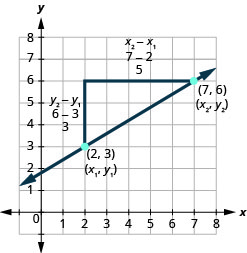
| Since we have two points, we will use the subscript notation. | [latex](\stackrel{x_1,y_1}{2,3})[/latex] [latex](\stackrel{x_2,y_2}{7,6})[/latex] |
| On the graph, we counted the rise of 3 and the run of 5. Notice that the rise of 3 can be found by subtracting the y-coordinates, 6 and 3, and the run of 5 can be found by subtracting the x-coordinates, 7 and 2. | [latex]\begin{array}{lrcl} & m & = & \frac{rise}{run}\\ & m & = & \frac{3}{5}\\ \end{array}[/latex] |
| We rewrite the rise and run by putting in the coordinates. | [latex]m=\frac{6-3}{7-2}[/latex] |
| The 6 is [latex]y_2[/latex], the y-coordinate of the second point, and 3 is [latex]y_1[/latex], the y-coordinate of the first point. So we can rewrite the slope using subscript notation. | [latex]m=\frac{y_2-y_1}{7-2}[/latex] |
| Also 7 is the x-coordinate of the second point, and 2 is the x-coordinate of the first point. So again we rewrite the slope using subscript notation. | [latex]m=\frac{y_2-y_1}{x_2-x_1}[/latex] |
We’ve shown that [latex]m=\frac{y_2-y_1}{x_2-x_1}[/latex] is really another version of [latex]m=\frac{rise}{run}[/latex]. We can use this formula to find the slope of a line when we have two points on the line.
Slope of a line between two points
The slope of the line between two points [latex](x_1,y_1)[/latex] and [latex](x_2,y_2)[/latex] is:
The slope is:
Example 3
Use the slope formula to find the slope of the line through the points [latex](-2,-3)[/latex] and [latex](-7,4)[/latex].
| We’ll call [latex](-2,-3)[/latex] point 1 and [latex](-7,4)[/latex] point 2. | [latex](\stackrel{x_1,y_1}{-2,-3})[/latex] [latex](\stackrel{x_2,y_2}{-7,4})[/latex] |
| Use the slope formula. | [latex]m=\frac{y_2-y_1}{x_2-x_1}[/latex] |
| Substitute the values.
Simplify. |
[latex]\begin{array}{lrcl} & m & = & \frac{4-(-3)}{-7-(-2)}\\ & m & = & \frac{7}{-5}\\ & m & = & -\frac{7}{5}\\ \end{array}[/latex] |
Let’s verify this slope on the graph shown.
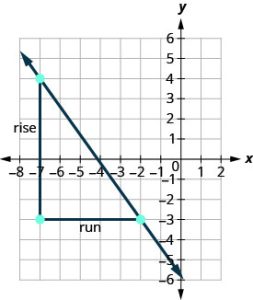
Exercise 3
Graph a Line Given a Point and the Slope
Up to now, in this chapter, we have graphed lines by plotting points, by using intercepts, and by recognizing horizontal and vertical lines.
We can also graph a line when we know one point and the slope of the line. We will start by plotting the point and then use the definition of slope to draw the graph of the line.
Example 4
Graph the line passing through the point [latex](1,-1)[/latex] whose slope is [latex]m=\frac{3}{4}[/latex].
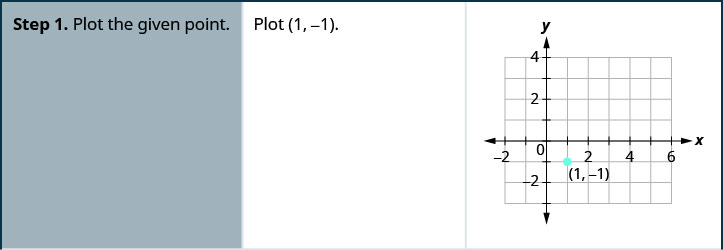

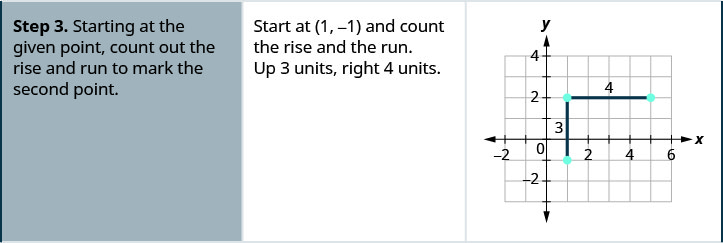

You can check your work by finding a third point. Since the slope is [latex]m=\frac{3}{4}[/latex], it can also be written as [latex]m=\frac{-3}{-4}[/latex] (negative divided by negative is positive!). Go back to [latex](1,-1)[/latex] and count out the rise, [latex]-3[/latex], and the run, [latex]-4[/latex].
Exercise 4
Graph the line passing through the point [latex](2,-2)[/latex] with the slope [latex]m=\frac{4}{3}[/latex]
Solution
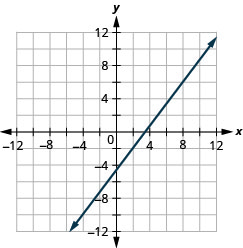
Graph the line passing through the point [latex](-2,3)[/latex] with the slope [latex]m=\frac{1}{4}[/latex]
Solution
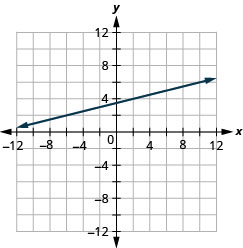
How to graph a line given a point and the slope:
- Plot the given point.
- Use the slope formula [latex]m=\frac{rise}{run}[/latex] to identify the rise and the run.
- Starting at the given point, count out the rise and run to mark the second point.
- Connect the points with a line.
Graph a Line Using Its Slope and Intercept
We have graphed linear equations by plotting points, using intercepts, recognizing horizontal and vertical lines, and using one point and the slope of the line. If we have an equation in slope-intercept form, it is easy to identify the slope and the y-intercept. The y-intercept is just another point on the line, so we can use the slope and the y-intercept to graph the line, just as we did when we had a point and the slope.
Let’s look at the graph of the equation [latex]y=\frac{1}{2}x+3[/latex] below and find its slope and y-intercept.
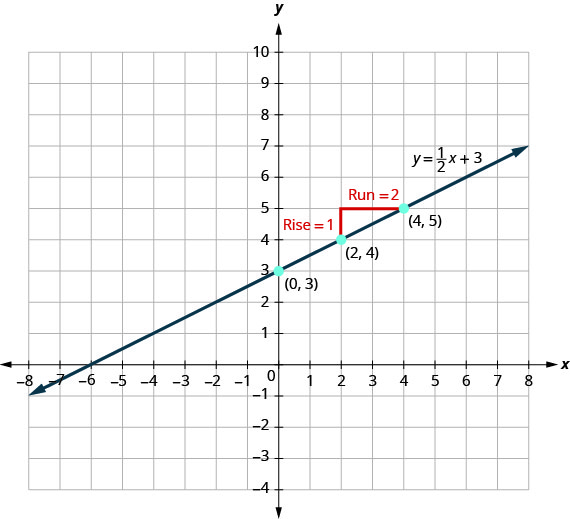
The red lines in the graph show us the rise is 1 and the run is 2. Substituting into the slope formula:
The y-intercept is [latex](0,3)[/latex].
Look at the equation of this line.
[latex]y={\frac{1}{2}}x+{3}[/latex]
Look at the slope and y-intercept.
slope [latex]m={\frac{1}{2}}[/latex] and y-intercept [latex](0,{3})[/latex]
When a linear equation is solved for y, the coefficient of the x term is the slope and the constant term is the y-coordinate of the y-intercept. We say that the equation [latex]y=\frac{1}{2}x+3[/latex] is in slope–intercept form.
[latex]m={\frac{1}{2}}[/latex]; y-intercept is [latex](0,{3})[/latex]
[latex]\begin{array}{lrcl} & y & = & {\frac{1}{2}}x+{3}\\ & y & = & {m}x+{b}\\ \end{array}[/latex]
Slope–Intercept Form of an Equation of a Line
The slope–intercept form of an equation of a line with slope m and y-intercept [latex](0,b)[/latex] is [latex]y=mx+b[/latex].
Let’s practice finding the values of the slope and y-intercept from the equation of a line.
Example 5
Identify the slope and y-intercept of the line from the equation:
(a) [latex]y=-\frac{4}{7}x-2[/latex] (b) [latex]x+3y=9[/latex]
(a) We compare our equation to the slope–intercept form of the equation.
| Write the slope-intercept form of the equation of the line. | [latex]y={m}x+{b}[/latex] |
| Write the equation of the line. | [latex]y={-\frac{4}{7}}x{-2}[/latex] |
| Identify the slope. | [latex]m={-\frac{4}{7}}[/latex] |
| Identify the y-intercept. | [latex](0,{-2})[/latex] |
(b) When an equation of a line is not given in slope-intercept form, our first step will be to solve the equation for y.
| Solve for y | [latex]x + 3y = 9[/latex] |
| Subtract x from each side. | [latex]3y = -x+9[/latex] |
| Divide both sides by 3. | [latex]\frac{3y}{3}=\frac{-x+9}{3}[/latex] |
| Simplify. | [latex]y=-\frac{1}{3}x+3[/latex] |
| Write the slope-intercept form of the equation of the line. | [latex]y={m}x+{b}[/latex] |
| Write the equation of the line. | [latex]y={-\frac{1}{3}}x+{3}[/latex] |
| Identify the slope. | [latex]m={-\frac{1}{3}}[/latex] |
| Identify the y-intercept. | [latex](0,{3})[/latex] |
Exercise 5
Identify the slope and y-intercept from the equation of the line.
a) [latex]y=\frac{2}{5}x-1[/latex]
b) [latex]x+4y=8[/latex]
Solution
a) [latex]m=\frac{2}{5}[/latex]; [latex](0,-1)[/latex]
b) [latex]m=-\frac{1}{4}[/latex]; [latex](0,2)[/latex]
Identify the slope and y-intercept from the equation of the line.
a) [latex]y=-\frac{4}{3}x+1[/latex]
b) [latex]3x+2y=12[/latex]
Solution
a)[latex]m=-\frac{4}{3}[/latex]; [latex](0,1)[/latex]
b) [latex]m=-\frac{3}{2}[/latex]; [latex](0,6)[/latex]
We have graphed a line using the slope and a point. Now that we know how to find the slope and y-intercept of a line from its equation, we can use the y-intercept as the point, and then count out the slope from there.
Example 6
Graph the line of the equation [latex]y=-x+4[/latex] using its slope and y-intercept.
[latex]\begin{array}{lrcl} & y & = & mx+b\\ \text{The equation is already in slope-intercept form.} & y & = & -x+4\\ \text{Identify the slope and y-intercept.} & m & = & {-1}; (0,{4})\\ \text{Plot the y-intercept. See the graph.}\\ \text{Identify the rise over run.} & m & = & \frac{-1}{1}\\ &&&\text{rise -1, run 1}\\ \text{Count out the rise and run to mark the second point.}\\ \end{array}[/latex]
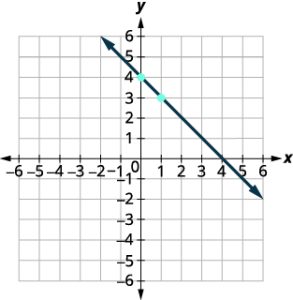
Draw the line as shown in the graph.
Exercise 6
Now that we have graphed lines by using the slope and y-intercept, let’s summarize all the methods we have used to graph lines.
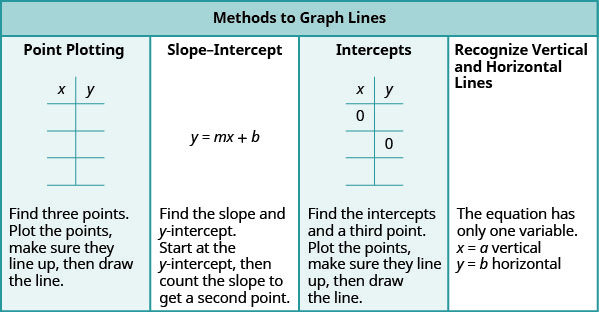
Choose the Most Convenient Method to Graph a Line
Now that we have seen several methods we can use to graph lines, how do we know which method to use for a given equation?
While we could plot points, use the slope–intercept form, or find the intercepts for any equation, if we recognize the most convenient way to graph a certain type of equation, we will be working more efficiently.
Generally, plotting points is not the most efficient way to graph a line. Let’s look for some patterns to help determine the most convenient method to graph a line.
Here are five equations we graphed in this chapter, and the method we used to graph each of them.
| Equation | Method | |
| 1 | [latex]x=2[/latex] | Vertical line |
| 2 | [latex]y=-1[/latex] | Horizontal line |
| 3 | [latex]x+2y=6[/latex] | Intercepts |
| 4 | [latex]4x-3y=12[/latex] | Intercepts |
| 5 | [latex]y=x+4[/latex] | Slope-intercept |
Equations #1 and #2 each have just one variable. Remember, in equations of this form the value of that one variable is constant; it does not depend on the value of the other variable. Equations of this form have graphs that are vertical or horizontal lines.
In equations #3 and #4, both x and y are on the same side of the equation. These two equations are of the form [latex]Ax+By=C[/latex]. We substituted [latex]y=0[/latex] to find the x– intercept and [latex]x=0[/latex] to find the y-intercept, and then found a third point by choosing another value for x or y.
Equation #5 is written in slope–intercept form. After identifying the slope and y-intercept from the equation, we used them to graph the line.
This leads to the following strategy.
Consider the form of the equation.
- If it only has one variable, it is a vertical or horizontal line.
- [latex]x=a[/latex] is a vertical line passing through the x-axis at a.
- [latex]y=b[/latex] is a horizontal line passing through the y-axis at b.
- If y is isolated on one side of the equation, in the form [latex]y=mx+b[/latex] graph by using the slope and y-intercept.
- Identify the slope and y-intercept and then graph.
- If the equation is of the form [latex]Ax+By=C[/latex] find the intercepts.
- Find the x– and y-intercepts, a third point, and then graph.
Example 7
Determine the most convenient method to graph each line:
a) [latex]y=5[/latex]
[latex]y=5[/latex] is a horizontal line going through the y-axis at 5.
This equation has only one variable, y. Its graph is a horizontal line crossing the y-axis at 5.
(b) [latex]4x-5y=20[/latex]
This equation is of the form [latex]Ax-By=C[/latex]. The easiest way to graph it will be to find the intercepts and one more point.
(c) [latex]x=-3[/latex]
There is only one variable, x. The graph is a vertical line crossing the x-axis at [latex]-3[/latex].
(d) [latex]y=-\frac{5}{9}x+8[/latex]
Since this equation is in [latex]y=mx+b[/latex] form, it will be easiest to graph this line by using the slope and y-intercept.
Exercise 7
Determine the most convenient method to graph each line:
a) [latex]3x+2y=12[/latex]
b) [latex]y=4[/latex]
c) [latex]y=\frac{1}{5}x-4[/latex]
d) [latex]x=-7[/latex]
Solution
a) intercepts
b) horizontal line
c) slope-intercept
d) vertical line
Determine the most convenient method to graph each line:
a) [latex]x=6[/latex]
b) [latex]y=-\frac{3}{4}x+1[/latex]
c) [latex]y=-8[/latex]
d) [latex]4x-3y=-1[/latex].
Solution
a) vertical line
b) slope-intercept
c) horizontal line
d) intercepts
Graph and Interpret Applications of Slope–Intercept
Many real-world applications are modeled by linear equations. We will take a look at a few applications here so you can see how equations written in slope–intercept form relate to real world situations.
Usually, when a linear equation models real-world data, different letters are used for the variables, instead of using only x and y. The variable names remind us of what quantities are being measured.
Also, we often will need to extend the axes in our rectangular coordinate system to bigger positive and negative numbers to accommodate the data in the application.
Example 8
The equation [latex]F=\frac{9}{5}C+32[/latex] is used to convert temperatures, C, on the Celsius scale to temperatures, F, on the Fahrenheit scale.
a) Find the Fahrenheit temperature for a Celsius temperature of 0.
[latex]\begin{array}{lrcl} \text{Find the Fahrenheit temperature for }\\ \text{a Celsius temperature of 0.} & F & = & \frac{9}{5}C+32\\ \text{Find F when } C=0. & F & = & \frac{9}{5}(0)+32\\ \text{Simplify.} & F & = & 32\\ \end{array}[/latex]
b) Find the Fahrenheit temperature for a Celsius temperature of 20.
[latex]\begin{array}{lrcl} \text{Find the Fahrenheit temperature for }\\ \text{a Celsius temperature of 20.} & F & = & \frac{9}{5}C+32\\ \text{Find F when } C=20. & F & = & \frac{9}{5}(20)+32\\ \text{Simplify.} & F & = & 36+32\\ & F & = & 68\\ \end{array}[/latex]
c) Interpret the slope and F-intercept of the equation.
Even though this equation uses F and C, it is still in slope–intercept form.
[latex]\begin{array}{lrcl} & {y} & = & m{x}+b\\ & {F} & = & m{C}+b\\ & F & = & \frac{9}{5}C+32\\ \end{array}[/latex]
The slope, [latex]\frac{9}{5}[/latex] means that the temperature Fahrenheit (F) increases 9 degrees when the temperature Celsius (C) increases 5 degrees.
The F-intercept means that when the temperature is 0 on the Celsius scale, it is 32 on the Fahrenheit scale.
d) Graph the equation.
We’ll need to use a larger scale than our usual. Start at the F-intercept [latex](0,32)[/latex], and then count out the rise of 9 and the run of 5 to get a second point as shown in the graph.
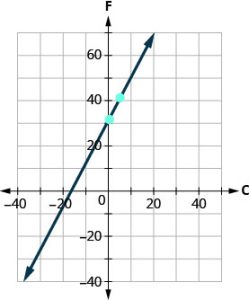
Exercise 8
The equation [latex]h=2s+50[/latex] is used to estimate a woman’s height in inches, h, based on her shoe size, s.
a) Estimate the height of a child who wears women’s shoe size 0.
b) Estimate the height of a woman with shoe size 8.
c) Interpret the slope and h-intercept of the equation.
d) Graph the equation.
Solution
a) 50 inches
b) 66 inches
c) The slope, 2, means that the height, h, increases by 2 inches when the shoe size, s, increases by 1. The h-intercept means that when the shoe size is 0, the height is 50 inches.
d)
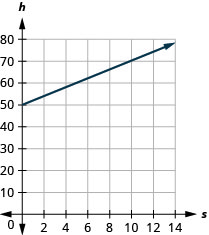
The equation [latex]T=\frac{1}{4}n+40[/latex] is used to estimate the temperature in degrees Fahrenheit, T, based on the number of cricket chirps, n, in one minute.
a) Estimate the temperature when there are no chirps.
b) Estimate the temperature when the number of chirps in one minute is 100.
c) Interpret the slope and T-intercept of the equation.
d) Graph the equation.
Solution
a) 40 degrees
b) 65 degrees
c) The slope, [latex]\frac{1}{4}[/latex], means that the temperature Fahrenheit (F) increases 1 degree when the number of chirps, n, increases by 4. The T-intercept means that when the number of chirps is 0, the temperature is 40°.
d)
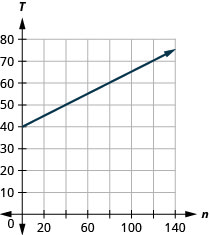
The cost of running some types of business has two components—a fixed cost and a variable cost. The fixed cost is always the same regardless of how many units are produced. This is the cost of rent, insurance, equipment, advertising, and other items that must be paid regularly. The variable cost depends on the number of units produced. It is for the material and labor needed to produce each item.
Example 9
Sam drives a delivery van. The equation [latex]C=0.5m+60[/latex] models the relation between his weekly cost, C, in dollars and the number of miles, m, that he drives.
a) Find Sam’s cost for a week when he drives 0 miles.
[latex]\begin{array}{lrcl} \text{Find Sam's cost for a week when he drives 0 miles} & C & = & 0.5m+60\\ \text{Find C when } m=0 & C & = & 0.5(0)+60\\ \text{Simplify.} & C & = & 60\\ \end{array}[/latex]
Sam’s costs are $60 when he drives 0 miles.
b) Find the cost for a week when he drives 250 miles.
[latex]\begin{array}{lrcl} \text{Find the cost for a week when }\\ \text{he drives 250 miles.} & C & = & 0.5m+60\\ \text{Find C when } m=250. & C & = & 0.5(250)+60\\ \text{Simplify.} & C & = & 185\\ \end{array}[/latex]
Sam’s costs are $185 when he drives 250 miles.
c) Interpret the slope and C-intercept of the equation.
[latex]\begin{array}{lrcl} & {y} & = & m{x}+b\\ & {C} & = & 0.5{m}+b\\ \end{array}[/latex]
The slope, 0.5, means that the weekly cost, C, increases by $0.50 when the number of miles driven, n, increases by 1.
The C-intercept means that when the number of miles driven is 0, the weekly cost is $60.
d) Graph the equation.
We’ll need to use a larger scale than our usual. Start at the C-intercept [latex](0,60)[/latex].
To count out the slope m = 0.5, we rewrite it as an equivalent fraction that will make our graphing easier.
[latex]\begin{array}{lrcl} & m & = & 0.5\\ \text{Rewrite as a fraction.} & m & = & \frac{0.5}{1}\\ \text{Multiply numerator and denominator by 100.} & m & = & \frac{0.5(100)}{1(100)}\\ \text{Simplify.} & m & = & \frac{50}{100}\\ \end{array}[/latex]
So to graph the next point, go up 50 from the intercept of 60 and then to the right 100. The second point will be (100, 110).

Exercise 9
Stella has a home business selling gourmet pizzas. The equation models the relation between her weekly cost, C, in dollars and the number of pizzas, p, that she sells.
a) Find Stella’s cost for a week when she sells no pizzas.
b) Find the cost for a week when she sells 15 pizzas.
c) Interpret the slope and C-intercept of the equation.
d) Graph the equation.
Solution
a) $25
b) $85
c) The slope, 4, means that the weekly cost, C, increases by $4 when the number of pizzas sold, p, increases by 1. The C-intercept means that when the number of pizzas sold is 0, the weekly cost is $25.
d)
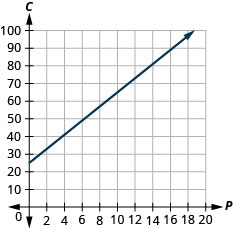
Loreen has a calligraphy business. The equation models the relation between her weekly cost, C, in dollars and the number of wedding invitations, n, that she writes.
a) Find Loreen’s cost for a week when she writes no invitations.
b) Find the cost for a week when she writes 75 invitations.
c) Interpret the slope and C-intercept of the equation.
d) Graph the equation.
Solution
a) $35
b) $170
c) The slope, 1.8, means that the weekly cost, C, increases by $1.80 when the number of invitations, n, increases by 1.
The C-intercept means that when the number of invitations is 0, the weekly cost is $35.
d)

Use Slopes to Identify Parallel and Perpendicular Lines
Two lines that have the same slope are called parallel lines. Parallel lines have the same steepness and never intersect.
We say this more formally in terms of the rectangular coordinate system. Two lines that have the same slope and different y-intercepts are called parallel lines. See the graph below.
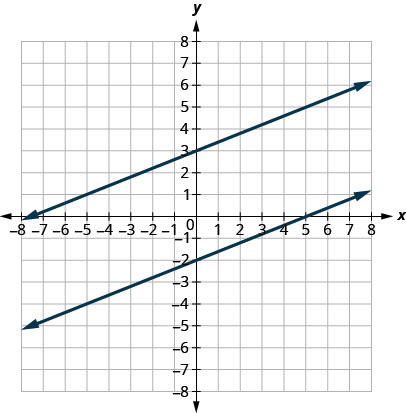
Verify that both lines have the same slope, [latex]m=\frac{2}{5}[/latex], and different y-intercepts.
What about vertical lines? The slope of a vertical line is undefined, so vertical lines don’t fit in the definition above. We say that vertical lines that have different x-intercepts are parallel, like the lines shown in this graph.
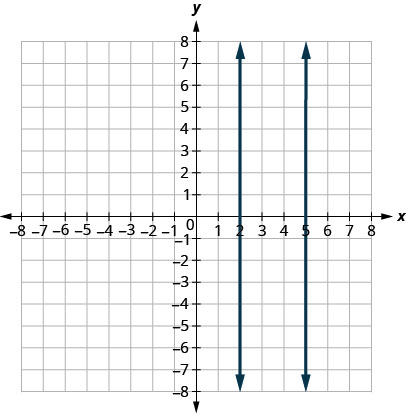
Parallel Lines
Parallel lines are lines in the same plane that do not intersect.
- Parallel lines have the same slope and different y-intercepts.
- If [latex]m_1[/latex] and [latex]m_2[/latex] are the slopes of two parallel lines, then [latex]m_1=m_2[/latex].
- Parallel vertical lines have different x-intercepts.
For lines that are not vertical, we can look at the slope–intercept form of the equations of lines and determine if the lines are parallel.
Example 10
Use slopes and y-intercepts to determine if the lines are parallel:
a) [latex]3x-2y=6[/latex] and [latex]y=\frac{3}{2}x+1[/latex]
| [latex]3x-2y=6[/latex] | [latex]y=\frac{3}{2}x+1[/latex] | |
| Solve the first equation for y. | [latex]\begin{array}{rcl} 3x-2y & = & 6\\ -2y & = & -3x+6\\ \frac{-2y}{-2} & = & \frac{-3x+6}{-2}\\ y & = & \frac{3}{2}x-3\\ \end{array}[/latex] | |
| The equation is now in slope-intercept form. The equation of the second line is already in slope-intercept form. | [latex]y=\frac{3}{2}x-3[/latex] | [latex]y=\frac{3}{2}x+1[/latex] |
| Identify the slope and y-intercept of both lines. | [latex]\begin{array}{rcl} y & = & \frac{3}{2}x-3\\ y & = & mx+b\\ m & = & \frac{3}{2}\\ \end{array}[/latex]
y-intercept is [latex](0,-3)[/latex] |
[latex]\begin{array}{rcl} y & = & \frac{3}{2}x+1\\ y & = & mx+b\\ m & = & \frac{3}{2}\\ \end{array}[/latex]
y-intercept is [latex](0,1)[/latex] |
The lines have the same slope and different y-intercepts and so they are parallel.
You may want to graph the lines to confirm whether they are parallel.
b) [latex]y=2x-3[/latex] and [latex]-6x+3y=-9[/latex]
| [latex]y=2x-3[/latex] | [latex]-6x+3y=-9[/latex] | |
| Solve the second equation for y. | [latex]\begin{array}{rcl} -6x+3y & = & -9\\ 3y & = & 6x-9\\ \frac{3y}{3} & = & \frac{6x-9}{3}\\ y & = & 2x-3\\ \end{array}[/latex] | |
| The second equation is now in slope-intercept form. The equation of the first line is already in slope-intercept form. | [latex]y=2x-3[/latex] | [latex]y=2x-3[/latex] |
| Identify the slope and y-intercept of both lines. | [latex]\begin{array}{rcl} y & = & 2x-3\\ y & = & mx+b\\ m & = & 2\\ \end{array}[/latex]
y-intercept is [latex](0,-3)[/latex] |
[latex]\begin{array}{rcl} y & = & 2x-3\\ y & = & mx+b\\ m & = & 2\\ \end{array}[/latex]
y-intercept is [latex](0,-3)[/latex] |
The lines have the same slope, but they also have the same y-intercepts. Their equations represent the same line, and we say the lines are coincident. They are not parallel; they are the same line.
Exercise 10
Use slopes and y-intercepts to determine if the lines are parallel:
a) [latex]2x+5y=5[/latex] and [latex]y=-\frac{2}{5}x-4[/latex]
b) [latex]y=-\frac{1}{2}x-1[/latex] and [latex]x+2y=-2[/latex]
Solution
a) parallel
b) not parallel; same line
Use slopes and y-intercepts to determine if the lines are parallel:
a) [latex]4x-3y=6[/latex] and [latex]y=\frac{4}{3}x-1[/latex]
b) [latex]y=\frac{3}{4}x-3[/latex] and [latex]3x-4y=12[/latex]
Solution
a) parallel
b) not parallel; same line
Example 11
Use slopes and y-intercepts to determine if the lines are parallel:
a) [latex]y=-4[/latex] and [latex]y=3[/latex]
We recognize right away from the equations that these are horizontal lines, and so we know their slopes are both 0.
Since the horizontal lines cross the y-axis at [latex]y=-4[/latex] and at [latex]y=3[/latex], we know the y-intercepts are [latex](0,-4)[/latex] and [latex](0,3)[/latex].
The lines have the same slope and different y-intercepts and so they are parallel.
b) [latex]x=-2[/latex] and [latex]x=-5[/latex]
We recognize right away from the equations that these are vertical lines, and so we know their slopes are undefined.
Since the vertical lines cross the x-axis at [latex]x=-2[/latex] and at [latex]x=-5[/latex], we know the x-intercepts are [latex](-2,0)[/latex] and [latex](-5,0)[/latex].
The lines are vertical and have different x-intercepts and so they are parallel.
Exercise 11
Use slopes and y-intercepts to determine if the lines are parallel:
a) [latex]y=8[/latex] and [latex]y=-6[/latex]
b) [latex]x=1[/latex] and [latex]x=-5[/latex]
Solution
a) parallel
b) parallel
Use slopes and y-intercepts to determine if the lines are parallel:
a) [latex]y=1[/latex] and [latex]y=-5[/latex]
b) [latex]x=8[/latex] and [latex]x=-6[/latex]
Solution
a) parallel
b) parallel
Let’s look at the lines whose equations are [latex]y=\frac{1}{4}x-1[/latex] and [latex]y=-4x+2[/latex] shown below.
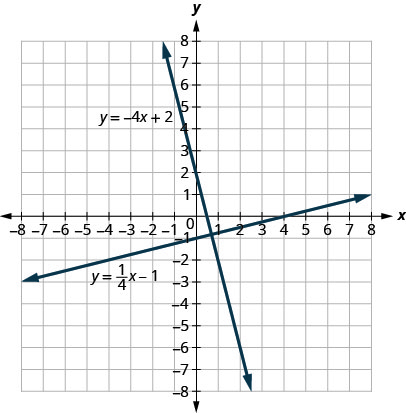
These lines lie in the same plane and intersect in right angles. We call these lines perpendicular.
If we look at the slope of the first line, [latex]m_1=\frac{1}{4}[/latex], and the slope of the second line, [latex]m_2=-4[/latex], we can see that they are negative reciprocals of each other. If we multiply them, their product, [latex]m_1m_2=(\frac{1}{4})(-4)=-1[/latex].
This is always true for perpendicular lines and leads us to this definition.
Perpendicular Lines
Perpendicular lines are lines in the same plane that form a right angle.
- If [latex]m_1[/latex] and [latex]m_2[/latex] are the slopes of two perpendicular lines, then:
- their slopes are negative reciprocals of each other, [latex]m_1=-\frac{1}{m_2}[/latex].
- the product of their slopes is [latex]-1[/latex], [latex]m_1m_2=-1[/latex].
- A vertical line and a horizontal line are always perpendicular to each other.
We were able to look at the slope–intercept form of linear equations and determine whether or not the lines were parallel. We can do the same thing for perpendicular lines.
We find the slope–intercept form of the equation and then see if the slopes are negative reciprocals. If the product of the slopes is [latex]-1[/latex], the lines are perpendicular.
Example 12
Use slopes to determine if the lines are perpendicular:
a) [latex]y=-5x-4[/latex] and [latex]x-5y=5[/latex]
| The first equation is in slope–intercept form. Solve the second equation for y. | [latex]y=-5x-4[/latex] | [latex]\begin{array}{rcl} x-5y & = & 5\\ -5y & = & -x+5\\ \frac{-5y}{-5} & = & \frac{-x+5}{-5}\\ y & = & \frac{1}{5}x-1\\ \end{array}[/latex] |
| Identify the slope of each line. | [latex]\begin{array}{rcl} y & = & -5x-4\\ y & = & mx+b\\ m_1 & = & -5\\ \end{array}[/latex] | [latex]\begin{array}{rcl} y & = & \frac{1}{5}x-1\\ y & = & mx+b\\ m_2 & = & \frac{1}{5}\\ \end{array}[/latex] |
The slopes are negative reciprocals of each other, so the lines are perpendicular. We check by multiplying the slopes. Since [latex]-5(\frac{1}{5})=-1[/latex], it checks.
b) [latex]7x+2y=3[/latex] and [latex]2x+7y=5[/latex]
| Solve the equations for y. | [latex]\begin{array}{rcl} 7x+2y & = & 3\\ 2y & = & -7x+3\\ \frac{2y}{2} & = & \frac{-7x+3}{2}\\ y & = & -\frac{7}{2}x+\frac{3}{2}\\ y & = & mx+b\\ m_1 & = & -\frac{7}{2}\\ \end{array}[/latex] | [latex]\begin{array}{rcl} 2x+7y & = & 5\\ 7y & = & -2x+5\\ \frac{7y}{7} & = & \frac{-2x+5}{7}\\ y & = & -\frac{2}{7}x+\frac{5}{7}\\ y & = & mx+b\\ m_2 & = & -\frac{2}{7}\\ \end{array}[/latex] |
The slopes are reciprocals of each other, but they have the same sign. Since they are not negative reciprocals, the lines are not perpendicular.
Exercise 12
Use slopes to determine if the lines are perpendicular:
a) [latex]y=-3x+2[/latex] and [latex]x-3y=4[/latex]
b) [latex]5x+4y=1[/latex] and [latex]4x+5y=3[/latex].
Solution
a) perpendicular
b) not perpendicular
Use slopes to determine if the lines are perpendicular:
a) [latex]y=2x-5[/latex] and [latex]x+2y=-6[/latex]
b) [latex]2x-9y=3[/latex] and [latex]9x-2y=1[/latex].
Solution
a) perpendicular
b) not perpendicular
Media Attributions
- 1.4.1 © OpenStax Intermediate Algebra 2e is licensed under a CC BY (Attribution) license
- 1.4.2 © OpenStax Intermediate Algebra 2e is licensed under a CC BY (Attribution) license
- 1.4.3 © OpenStax Intermediate Algebra 2e is licensed under a CC BY (Attribution) license
- 1.4.6 © OpenStax Intermediate Algebra 2e is licensed under a CC BY (Attribution) license
- 1.4.7 © OpenStax Intermediate Algebra 2e is licensed under a CC BY (Attribution) license
- 1.4.8 © OpenStax Intermediate Algebra 2e is licensed under a CC BY (Attribution) license
- 1.4.9 © OpenStax Intermediate Algebra 2e is licensed under a CC BY (Attribution) license
- 1.4.10 © OpenStax Intermediate Algebra 2e is licensed under a CC BY (Attribution) license
- 1.4.11 © OpenStax Intermediate Algebra 2e is licensed under a CC BY (Attribution) license
- 1.4.12 © OpenStax Intermediate Algebra 2e is licensed under a CC BY (Attribution) license
- 1.4.13 © OpenStax Intermediate Algebra 2e is licensed under a CC BY (Attribution) license
- 1.4.14 © OpenStax Intermediate Algebra 2e is licensed under a CC BY (Attribution) license
- 1.4.15 © OpenStax Intermediate Algebra 2e is licensed under a CC BY (Attribution) license
- 1.4.16 © OpenStax Intermediate Algebra 2e is licensed under a CC BY (Attribution) license
- 1.4.17 © OpenStax Intermediate Algebra 2e is licensed under a CC BY (Attribution) license
- 1.4.18 © OpenStax Intermediate Algebra 2e is licensed under a CC BY (Attribution) license
- 1.4.21 © OpenStax Intermediate Algebra 2e is licensed under a CC BY (Attribution) license
- 1.4.22 © OpenStax Intermediate Algebra 2e is licensed under a CC BY (Attribution) license
- 1.4.23 © OpenStax Intermediate Algebra 2e is licensed under a CC BY (Attribution) license
- 1.4.24 © OpenStax Intermediate Algebra 2e is licensed under a CC BY (Attribution) license
- 1.4.25 © OpenStax Intermediate Algebra 2e is licensed under a CC BY (Attribution) license
- 1.4.26 © OpenStax Intermediate Algebra 2e is licensed under a CC BY (Attribution) license
- 1.4.27 © OpenStax Intermediate Algebra 2e is licensed under a CC BY (Attribution) license
- 1.4.28 © OpenStax Intermediate Algebra 2e is licensed under a CC BY (Attribution) license
- 1.4.29 © OpenStax Intermediate Algebra 2e is licensed under a CC BY (Attribution) license
- 1.4.30 © OpenStax Intermediate Algebra 2e is licensed under a CC BY (Attribution) license
The measure of the steepness of a line.
Slope m and y-intercept, latex[/latex] is [latex]y=mx+b[/latex].
Parallel lines are lines in the same plane that do not intersect.
Perpendicular lines are lines in the same plane that form a right angle.
Lines in the same plane that form a right angle.

